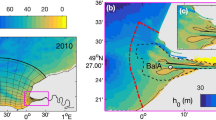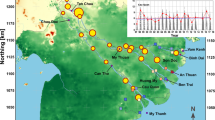Abstract
Wetlands in the Mississippi River deltaic plain are deteriorating1 in part because levees and control structures starve them of sediment2,3,4. In spring 2011 a record-breaking flood brought discharge on the lower Mississippi River to dangerous levels, forcing managers to divert up to 3,500 m3 s−1 of water to the Atchafalaya River Basin5. Here we use field-calibrated satellite data to quantify differences in inundation and sediment-plume patterns between the Mississippi and Atchafalaya River. We assess the impact of these extreme outflows on wetland sedimentation, and use in situ data collected during the historic flood to characterize the Mississippi plume’s hydrodynamics and suspended sediment. We show that a focused, high-momentum jet emerged from the leveed Mississippi, and delivered sediment far offshore. In contrast, the plume from the Atchafalaya was more diffuse; diverted water inundated a large area, and sediment was trapped within the coastal current. The largest sedimentation, of up to several centimetres, occurred in the Atchafalaya Basin despite the larger sediment load carried by the Mississippi. Sediment accumulation was lowest along the shoreline between the two river sources. We conclude that river-mouth hydrodynamics and wetland sedimentation patterns are mechanistically linked, providing results that are relevant for plans to restore deltaic wetlands using artificial diversions2,3,4,6,7,8.
This is a preview of subscription content, access via your institution
Access options
Subscribe to this journal
Receive 12 print issues and online access
$259.00 per year
only $21.58 per issue
Buy this article
- Purchase on Springer Link
- Instant access to full article PDF
Prices may be subject to local taxes which are calculated during checkout



Similar content being viewed by others
References
Couvillion, B. R. et al. US Geological Survey Scientific Investigations Map 3164, scale 1:265,000, 12 p. pamphlet (2011).
Day, J. W. et al. Restoration of the Mississippi Delta: Lessons from Hurricanes Katrina and Rita. Science 315, 1679–1684 (2007).
Kim, W. et al. Is it feasible to build new land in the Mississippi River Delta? Eos Trans. AGU 90, 373–374 (2009).
Paola, C. et al. Natural processes in delta restoration: Application to the Mississippi Delta. Annu. Rev. Mar. Sci. 3, 67–91 (2011).
Blum, M. D. & Roberts, H. H. Drowning of the Mississippi Delta due to insufficient sediment supply and global sea-level rise. Nature Geosci. 2, 488–491 (2009).
Kearney, M. S., Riter, J. C. A. & Turner, R. E. Freshwater river diversions for marsh restoration in Louisiana: Twenty-six years of changing vegetative cover and marsh area. Geophys. Res. Lett. 38, L16405 (2011).
Falcini, F. & Jerolmack, D. J. A potential vorticity theory for the formation of elongate channels in river deltas and lakes. J. Geophys. Res. 115, F04038 (2010).
Batker, D. et al. Gaining Ground—Wetlands, Hurricanes and the Economy: The Value of Restoring the Mississippi River Delta (Earth Economics Tacoma, WA, 2010). Available at http://www.eartheconomics.org/FileLibrary/file/Reports/Louisiana/Earth_Economics_Report_on_the_Mississippi_River_Delta_compressed.pdf.
Törnqvist, T. E. et al. Mississippi Delta subsidence primarily caused by compaction of Holocene strata. Nature Geosci. 1, 173–176 (2008).
Kirwan, M. L. & Murray, A. B. A coupled geomorphic and ecological model of tidal marsh evolution. Proc. Natl Acad. Sci. USA 104, 6118–6122 (2007).
Kirwan, M. L. et al. Limits on adaptability of coastal marshes to rising sea level. Geophys. Res. Lett. 37, 1–5 (2010).
Donoghue, J. Sea level history of the northern Gulf of Mexico coast and sea level rise scenarios for the near future. Climatic Change 107, 17–33 (2011).
Coastal Protection and Restoration Authority of Louisiana Louisiana’s Comprehensive Master Plan for a Sustainable Coast. Coastal Protection and Restoration Authority of Louisiana. Baton Rouge, LA (2012); available at http://www.coastalmasterplan.louisiana.gov/2012-master-plan/final-master-plan/.
Hu, C. et al. Mississippi River water in the Florida Straits and in the Gulf Stream off Georgia in summer 2004. Geophys. Res. Lett. 32, L14606 (2005).
Shi, W. & Wang, M. Satellite observations of flood-driven Mississippi River plume in the spring of 2008. Geophys. Res. Lett 36, L07607 (2009).
Peckham, S. D. A new method for estimating suspended sediment concentrations and deposition rates from satellite imagery based on the physics of plumes. Comput. Geosci. 34, 1198–1222 (2008).
Walker, N. D., Rouse, L. J. Jr, Fargion, G. S. & Biggs, D. C. The Great Flood of summer 1993: Mississippi River discharge studied. Eos Trans. AGU 75, 414–415 (1994).
Schiller, R. V., Kourafalou, V. H., Hogan, P. J. & Walker, N. D. The dynamics of the Mississippi River plume: impact of topography, wind and offshore forcing on the fate of plume waters. J. Geophys. Res. 116, C06029 (2011).
Round, F. E., Crawford, R. M. & Mann, D. G. The Diatoms, Biology And Morphology of the Genera 747 (Cambridge Univ. Press, 1990).
White, J. R. et al. Mississippi River flood of 2008: Observations of a large freshwater diversion on physical, chemical, and biological characteristics of a shallow estuarine lake. Environ. Sci. Technol. 43, 5599–5604 (2009).
Bagnold, R. An approach to the sediment transport problem from general physics. US Geol. Surv. Prof. Paper 422-I (1966).
Bignami, F. et al. On the dynamics of surface cold filaments in the Mediterranean Sea. J. Mar. Res. 74, 429–442 (2008).
Narimousa, S., Maxworthy, T. & Spedding, G. R. Experiments on the structure and dynamics of forced, quasi-two-dimensional turbulence. J. Fluid Mech. 223, 113–133 (1991).
Stern, M. E. & Austin, J. Entrainment of shelf water by a bifurcating continental boundary current. J. Phys. Oceanogr. 25, 3118–3131 (1995).
Wood, R. B. & McIntyre, M. E. A general theorem on angular-momentum changes due to potential vorticity mixing and on potential-energy changes due to buoyancy mixing. J. Atmos. Sci. 67, 1261–1274 (2010).
Dritschel, D. G. & Scott, R. K. Jet sharpening by turbulent mixing. Phil. Trans. R. Soc. A 369, 754–770 (2011).
Nittrouer, J. A. et al. Mitigating land loss in coastal Louisiana by controlled diversion of Mississippi River sand. Nature Geosci. 5, 534–537 (2012).
Day, J. W. et al. Vegetation death and rapid loss of surface elevation in two contrasting Mississippi delta salt marshes: The role of sedimentation, autocompaction and sea-level rise. Ecol. Eng. 37, 229–240 (2011).
Acknowledgements
This work was supported by NSF-RAPID awards (EAR-1140269; OCE-1140307), a NOAA grant (NA11OAR4310101) and the University of Pennsylvania’s Benjamin Franklin Fellowship, and received further logistical support from the Luquillo Critical Zone Observatory (EAR-0722476). The CNR WORK was partially financially supported by the European Commission MyOcean-2 Project grant agreement (283367). We thank C. Vervaeke and A. Constantin for assistance with the helicopter survey and T. Touchet, M. Enache, M. Mills and T. Dura for assistance with sediment and diatom analyses. Field support from the crew of R/V Acadiana, C. Zhang, P. Dash, A. and A. Kolker is very much appreciated. We also thank V. Forneris for the collection of L-1A data products. Any use of trade, product or firm names is for descriptive purposes alone and does not imply endorsement by the US Government. This paper is a contribution to IGCP project 588 (Preparing for coastal change) and PALSEA.
Author information
Authors and Affiliations
Contributions
F.F. performed the satellite analysis, developed the potential vorticity theory for suspended sediment and coordinated the overall study. N.S.K. contributed to collection, analysis and presentation of the wetland sediment and diatom data. L.M. and C.B.L. contributed to the overall study and led the boat survey. B.P.H. contributed to the overall study approach and participated in data interpretation. M.D. and A.S. performed the hydrographic and suspended sediment data acquisition and analysis. K.L.M. contributed to the overall study approach and led the wetland sediment survey. R.S., S.C. and G.V. contributed to the processing of satellite data, subsequent analysis and presentation. C.L. contributed to the collection of river-mouth flow velocity profiles, subsequent data analysis and presentation. D.J.J. supervised the research, participated in data interpretation and led the writing of the main text. All authors contributed to the writing of this manuscript.
Corresponding author
Ethics declarations
Competing interests
The authors declare no competing financial interests.
Supplementary information
Supplementary Information
Supplementary Information (PDF 2341 kb)
Rights and permissions
About this article
Cite this article
Falcini, F., Khan, N., Macelloni, L. et al. Linking the historic 2011 Mississippi River flood to coastal wetland sedimentation. Nature Geosci 5, 803–807 (2012). https://doi.org/10.1038/ngeo1615
Received:
Accepted:
Published:
Issue Date:
DOI: https://doi.org/10.1038/ngeo1615
This article is cited by
-
Responses of Coastal Wetlands to Rising Sea-Level Revisited: The Importance of Organic Production
Estuaries and Coasts (2024)
-
Land loss due to human-altered sediment budget in the Mississippi River Delta
Nature Sustainability (2023)
-
Hurricane Harvey Storm Sedimentation in the San Bernard National Wildlife Refuge, Texas: Fluvial Versus Storm Surge Deposition
Estuaries and Coasts (2020)
-
Linking flow-stream variability to grain size distribution of suspended sediment from a satellite-based analysis of the Tiber River plume (Tyrrhenian Sea)
Scientific Reports (2019)
-
Tidal Wetlands in a Changing Climate: Introduction to a Special Feature
Wetlands (2019)



